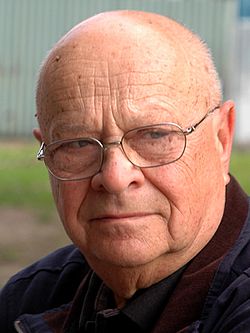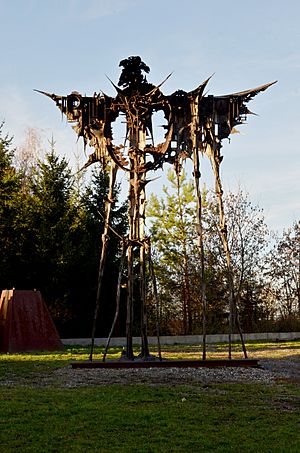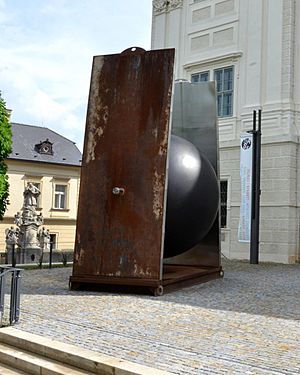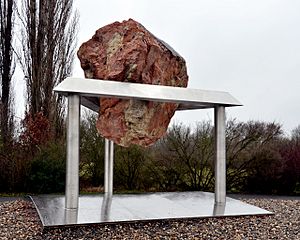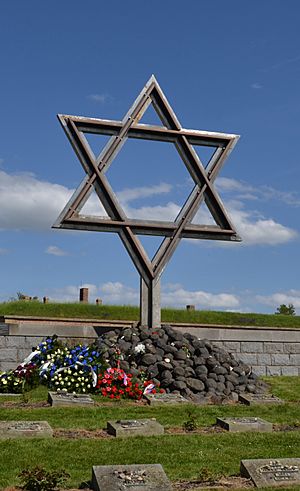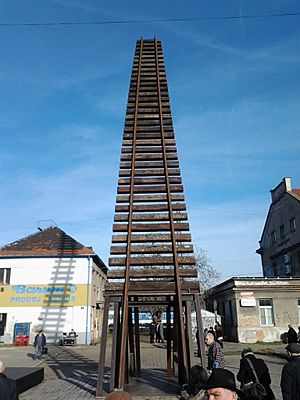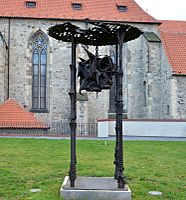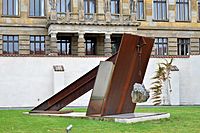Aleš Veselý facts for kids
Aleš Veselý (born February 3, 1935, in Čáslav – died December 14, 2015, in Prague) was a famous Czech sculptor, graphic artist, painter, and art teacher. He is known for his powerful and often large-scale abstract sculptures.
Contents
Life of Aleš Veselý
Aleš Veselý grew up in a family with Jewish heritage. During World War II, when he was just six years old, he had to wear a special yellow star in public. This difficult experience stayed with him his whole life. His father and sister were sent to a concentration camp, but thankfully they survived and came home after the war. Sadly, many of his relatives died during the war. Because he was Jewish, Aleš wasn't allowed to go to school during the war. He finished primary school only after the war ended.
From a young age, Aleš loved to paint. He later attended an Art school in Prague. After two years, his teachers suggested he go to the Academy of Fine Arts in Prague. He was accepted at age seventeen, even though he was younger than usual and didn't have a high school diploma. He studied graphic arts there. During his studies, he also learned to play the piano and compose his own music. For a while, he even thought about becoming a professional musician. But when abstract art became popular, he decided to focus on visual art.
After finishing his studies in 1958, Aleš Veselý faced challenges from the government. His art didn't fit the official ideas of the time, so he lost government support. In the late 1950s, he became interested in using different materials in his abstract art. He was part of a group of artists who held secret art shows called Confrontation. These shows were important because they displayed modern Czech art that was different from what the government allowed.
In the early 1960s, the government became a bit more relaxed. Aleš Veselý had his first solo art show in 1963. The next year, he showed his sculptures Chair-Usurper and Enigmatic Objects at a big exhibition. In 1965, he won the Critics' Prize at the Biennale de Paris, an important art event in France.
In 1967, Aleš Veselý was invited to a special event in Ostrava where sculptors could create large works using steel. He had access to lots of materials and made seven sculptures there. His most famous sculpture, Kaddish, was created during this time. He saw it as a personal prayer for his father, who had recently passed away. This project ended when the Soviet army invaded Czechoslovakia in 1968.
After the invasion, the government became very strict again. Aleš Veselý was among the artists who were persecuted. He couldn't show his art or get public art jobs. He had to quickly save his sculpture Kaddish from being destroyed. He moved his sculptures to a demolished mill in the village of Středokluky, which became his studio.
In the 1970s, he worked mostly in isolation at his studio. This gave him a lot of creative freedom. He was also part of an alternative music group called Frog's Slime. In the late 1970s, he was allowed to travel and create large sculptures in Germany.
In 1986, Aleš Veselý received a scholarship from America. The secret police tried to stop him from leaving, but he eventually got his passport. In 1988, he was invited to show his art at the Olympic Games in Seoul, South Korea. His sculpture Testimony was placed in the Olympic Park.
After the Velvet Revolution in 1989, which ended the communist rule, Aleš Veselý had his first official art show in 27 years. He also started teaching sculpture at the Academy of Fine Arts in Prague. He taught there until 2006 and then at another university until 2015. He had many important exhibitions in the 1990s, both in the Czech Republic and abroad. In 2015, on his 80th birthday, several exhibitions of his work were held in Prague. Aleš Veselý passed away unexpectedly in December 2015.
Scholarships
- 1995 Pollock-Krasner Foundation Grant, Chicago, IL, USA
- 1993 Arts Link Fellowship at The Fabric Workshop, Philadelphia, PA, USA
- 1986 International Sculpture Center Fellowship, Washington, D.C., USA
Awards
- 1994 The Chicago Prize, John David Mooney Foundation, Chicago, IL, USA
- 1969 Matthias Braun Prize for the Kaddish sculpture at the exhibition Sculpture and the City, Liberec
- 1965 Critics' Prize for the sculpture Chair Usurper at the 4th Biennale de Paris, France
Artworks of Aleš Veselý
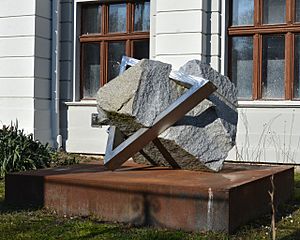
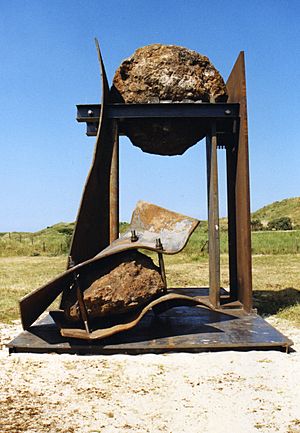

In the late 1950s, Aleš Veselý became a key artist in Czech Informel. This was a style of abstract art that used strong emotions and unusual materials. It was a way for artists to express themselves when the government only wanted art that supported its ideas. His art often used dark colors like black and brown. He used materials like metal, wood, and sand. He often made them look old or damaged on purpose, to show strong feelings.
Between 1961 and 1963, he created a series called Stigmatic Objects. These were sculptures made of wood and metal that looked like deep wounds or scars. They showed feelings of pain or trauma. He also created large sculptures for public spaces, like Enigma of the Circle at the old Prague airport in 1965.
In the second half of the 1960s, Aleš Veselý's art became even more imaginative. His sculpture Chair - Usurper won an award in Paris in 1965. This artwork showed a chair that looked both like a victim and a destructive force. Working on the huge Kaddish sculpture in Ostrava was very important for him. He realized that working on a large scale helped his imagination.
From the early 1970s, he worked mainly in his studio in Středokluky. He created many sculptures using old metal and wood parts. These included "Spatial Records" like chairs, seats, and wagons. He also made large outdoor sculptures around his home. In the late 1970s and early 1980s, he created several big sculptures for public spaces in Germany.
In the 1980s, Aleš Veselý made many large "drawings by painting" on paper. These were designs for huge sculptures and buildings that were often difficult to build. His designs often involved large machines with weights and springs. He also designed gates and corridors where passage was blocked by heavy stones. An example is Cage (1991) at the National Gallery in Prague.
His travels to places like Seoul (1988), Japan (1994), and Israel influenced his work. He started designing huge art projects for landscapes, which could only be seen from above. A main idea in his art was gravity. Many of his sculptures showed heavy objects lifted high or balanced in unusual ways. For example, Hovering Rock (1995) gave the illusion of a huge rock floating in the air.
Later, Aleš Veselý often used mirrors in his sculptures, like in Chamber of Light (1998-2001) in Vilnius. He always aimed for precision in his art. He believed that the final look of his work should be very exact. He liked to make changes until the very last moment.
His sculptures can be found in public places all over the world. His studio in Středokluky became a unique sculpture park, which is seen as a complete work of art itself.
Sculptures in public space
- 2015 Gate of No Return, Memorial of Silence, Prague Bubny
- 2015 The Law of Irreversibility, Terezín Crematorium
- 2014 Entry into the Law, Gallery of the Central Bohemian Region in Kutná Hora
- 2010 Distance and Touches, Masaryk University in Brno, stainless steel, stone, 300×560×150 cm
- 1998-2001 Chamber of Light, Europos Parkas, Vilnius, iron, steel and boulders, 777×430×430 cm
- 2008 Holocaust Memorial, in front of the former synagogue in Kutná Hora, stone, stainless steel, iron, 200×200×200 cm
- 1999 Messenger, Sculpture Park, Wijk aan Zee, steel and boulders, 530×376×609 cm
- 1996 Memento, sculpture from 1968 permanently installed in Venray, stainless steel, h. 450 cm
- 1995 Magen David, Terezin Memorial, stainless steel, bronzed railway tracks, boulders, h. 560 cm
- 1994 Doublebench, Faret Tachikawa, Tokyo, stainless steel, diorite, 240 × 240 × 70 cm
- 1988 Testimony, 1968 sculpture permanently installed in the Olympic Park in Seoul, stainless steel, h. 280 cm
- 1980 Ten, welded stainless steel statue in front of Ed. Spranger, Hamm, h. 12 m
- 1979 Iron Report, city park, Bochum, set of three iron sculptures, I. 750 × 900 × 220 cm, II. 330 × 360 × 180 cm, III. 280 × 220 × 110 cm
- 1973 Oven from Jericho, Nové Sedlo near Karlovy Vary, stainless steel, 210 × 390 × 230 cm
- 1967-68 Kaddish, (originally in Ostrava) from 1971 sculpture placed in the artist's studio in Středokluky, welded stainless steel, h. 710 cm
- 1965 Enigma of the Circle, Old Airport, Prague Ruzyně
- 1963 Indetermination of the Circle and Straight Line, CSA, via Bissolati, Rome, wood, iron and acronex (destroyed in 1994 with the knowledge of the Czech Embassy)
Gate of No Return
On March 9, 2015, a large sculpture by Aleš Veselý called Gate of No Return was revealed at Prague-Bubny railway station. It is a 20-meter tall rail that points towards the sky, like Jacob's Ladder. This date is important because it marks the night in 1944 when many prisoners from the Terezín concentration camp were killed in Auschwitz.
The giant sculpture stands where Jewish people were once sent on trains to concentration camps. It reminds us of the sad fate of Prague Jews. From this station, about 50,000 Jewish citizens were sent away between 1941 and 1945. The sculpture shows that the station is now becoming a Memorial of Silence to remember the victims of the Holocaust.
Representation in collections
Aleš Veselý's works are held in many important art collections around the world, including:
- Guggenheim Museum, New York, USA
- Centre Georges Pompidou, Paris, France
- Galleria degli Uffizi, Firenze, Italy
- Sculpture Collection - Olympic Park, Seoul, South Korea
- Albertina, Vienna, Austria
- Museum Folkwang, Essen, Germany
- French National Library, Paris, France
- National Gallery, Prague
- Jewish Museum, Prague
- Museum Kampa, Prague
Solo exhibitions (selection)
Aleš Veselý had many solo exhibitions throughout his career. Some notable ones include:
- 2016 No Beginning, No End - A Tribute to Aleš Veselý, Museum Kampa, Prague
- 2015 Four exhibitions celebrating his 80th birthday in Prague
- 2011 Duration and Settling, DOX Centre for Contemporary Art, Prague
- 2009 Aleš Veselý in Josef Pleskot's Spaces, Litomyšl
- 2005/06 Selected works from 1959-2005, Egon Schiele Art Centre, Český Krumlov
- 2003 Infinite Point, Carosso Fine Art, New York, USA
- 1992 Aleš Veselý: Point of Limit, Ballroom of the Prague Castle
- 1990 Aleš Veselý, Nová síň, Prague
- 1970 State Jewish Museum, Prague
- 1969 Wiener Secession, Vienna, Austria
Works by Aleš Veselý in the Sculpture park of the National Gallery in Prague
See Also
 In Spanish: Aleš Veselý para niños
In Spanish: Aleš Veselý para niños


